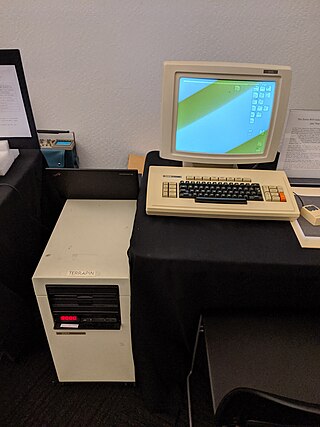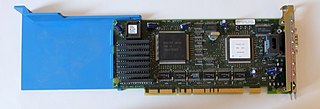
A motherboard is the main printed circuit board (PCB) in general-purpose computers and other expandable systems. It holds and allows communication between many of the crucial electronic components of a system, such as the central processing unit (CPU) and memory, and provides connectors for other peripherals. Unlike a backplane, a motherboard usually contains significant sub-systems, such as the central processor, the chipset's input/output and memory controllers, interface connectors, and other components integrated for general use.

A workstation is a special computer designed for technical or scientific applications. Intended primarily to be used by a single user, they are commonly connected to a local area network and run multi-user operating systems. The term workstation has been used loosely to refer to everything from a mainframe computer terminal to a PC connected to a network, but the most common form refers to the class of hardware offered by several current and defunct companies such as Sun Microsystems, Silicon Graphics, Apollo Computer, DEC, HP, NeXT, and IBM which powered the 3D computer graphics revolution of the late 1990s.

The Xerox Star workstation, officially named Xerox 8010 Information System, is the first commercial personal computer to incorporate technologies that have since become standard in personal computers, including a bitmapped display, a window-based graphical user interface, icons, folders, mouse (two-button), Ethernet networking, file servers, print servers, and e-mail.

Micro Channel architecture, or the Micro Channel bus, is a proprietary 16- or 32-bit parallel computer bus introduced by IBM in 1987 which was used on PS/2 and other computers until the mid-1990s. Its name is commonly abbreviated as "MCA", although not by IBM. In IBM products, it superseded the ISA bus and was itself subsequently superseded by the PCI bus architecture.
Apollo/Domain was a range of workstations developed and produced by Apollo Computer from circa 1980 to 1989. The machines were built around the Motorola 68k family of processors, except for the DN10000, which had from one to four of Apollo's RISC processors, named PRISM.

Apollo Computer Inc., founded in 1980 in Chelmsford, Massachusetts, by William Poduska and others, developed and produced Apollo/Domain workstations in the 1980s. Along with Symbolics and Sun Microsystems, Apollo was one of the first vendors of graphical workstations in the 1980s. Like computer companies at the time and unlike manufacturers of IBM PC compatibles, Apollo produced much of its own hardware and software.

The Personal System/2 or PS/2 is IBM's second generation of personal computers. Released in 1987, it officially replaced the IBM PC, XT, AT, and PC Convertible in IBM's lineup. Many of the PS/2's innovations, such as the 16550 UART, 1440 KB 3.5-inch floppy disk format, 72-pin SIMMs, the PS/2 port, and the VGA video standard, went on to become standards in the broader PC market.
Convergent Technologies, Inc., was an American computer company formed by a small group of people who left Intel Corporation and Xerox PARC in 1979. Among the founders were CEO Allen Michels, VP Engineering Bob Garrow, head of marketing Kal Hubler, and operating system architect Ben Wegbreit. Convergent was primarily an OEM vendor with their computers resold by other manufacturers such as ADP, AT&T, Burroughs, Four-Phase Systems, Gould, Mohawk, Monroe Data Systems, NCR, and Prime. The company was purchased by Unisys in 1988.

A diskless node is a workstation or personal computer without disk drives, which employs network booting to load its operating system from a server.
The MIPS Magnum was a line of computer workstations designed by MIPS Computer Systems, Inc. and based on the MIPS series of RISC microprocessors. The first Magnum was released in March, 1990, and production of various models continued until 1993 when SGI bought MIPS Technologies. SGI cancelled the MIPS Magnum line to promote their own workstations including the entry-level SGI Indy.
Apricot Computers was a British electronic company that produced desktop personal computers in the mid-1980s.
The 3Com 3Server was a headless dedicated network-attached storage machine designed to run 3Com local area network (LAN) server software, 3+Share.

The Compaq Deskpro is a line of business-oriented desktop computers manufactured by Compaq, then discontinued after the merger with Hewlett-Packard. Models were produced containing microprocessors from the 8086 up to the x86-based Intel Pentium 4.
Since the rise of the personal computer in the 1980s, IBM and other vendors have created PC-based IBM-compatible mainframes which are compatible with the larger IBM mainframe computers. For a period of time PC-based mainframe-compatible systems had a lower price and did not require as much electricity or floor space. However, they sacrificed performance and were not as dependable as mainframe-class hardware. These products have been popular with mainframe developers, in education and training settings, for very small companies with non-critical processing, and in certain disaster relief roles.

The Sun386i is a discontinued hybrid UNIX workstation/PC compatible computer system produced by Sun Microsystems, launched in 1988. It is based on the Intel 80386 microprocessor but shares many features with the contemporary Sun-3 series systems.
Corvus Systems was a computer technology company that offered, at various points in its history, computer hardware, software, and complete PC systems.
3+Share, also known simply as 3+ or 3 Plus, was a pioneering file and print sharing product from 3Com. Introduced in the early 1980s, 3+Share was competitive with Novell's NetWare in the network server business throughout the 1980s. It was replaced by the joint Microsoft-3Com LAN Manager in 1990, but 3Com exited the server market in 1991.
RM Nimbus was a range of personal computers from British company Research Machines sold from 1985 until the early 1990s, after which the designation Nimbus was discontinued. The first of these computers, the RM Nimbus PC-186, was not IBM PC compatible, but its successors the PC-286 and PC-386 were. RM computers were predominantly sold to schools and colleges in the United Kingdom for use as LAN workstations in classrooms.

The history of the personal computer as a mass-market consumer electronic device began with the microcomputer revolution of the 1970s. A personal computer is one intended for interactive individual use, as opposed to a mainframe computer where the end user's requests are filtered through operating staff, or a time-sharing system in which one large processor is shared by many individuals. After the development of the microprocessor, individual personal computers were low enough in cost that they eventually became affordable consumer goods. Early personal computers – generally called microcomputers – were sold often in electronic kit form and in limited numbers, and were of interest mostly to hobbyists and technicians.
The VT1000 was a monochrome X Window System computer terminal introduced by Digital Equipment Corporation (DEC) in April 1990. The VT1200 replaced the VT1000 later that year, consisting of a code update and a bump in the RAM from 1 to 2 MB. All of the VT1000 series communicated with their host computers over Ethernet, supporting TCP/IP as well as DEC's terminal-oriented Local Area Transport (LAT) protocol. They also included standard serial ports to allow basic terminal emulation, built into the ROM.









